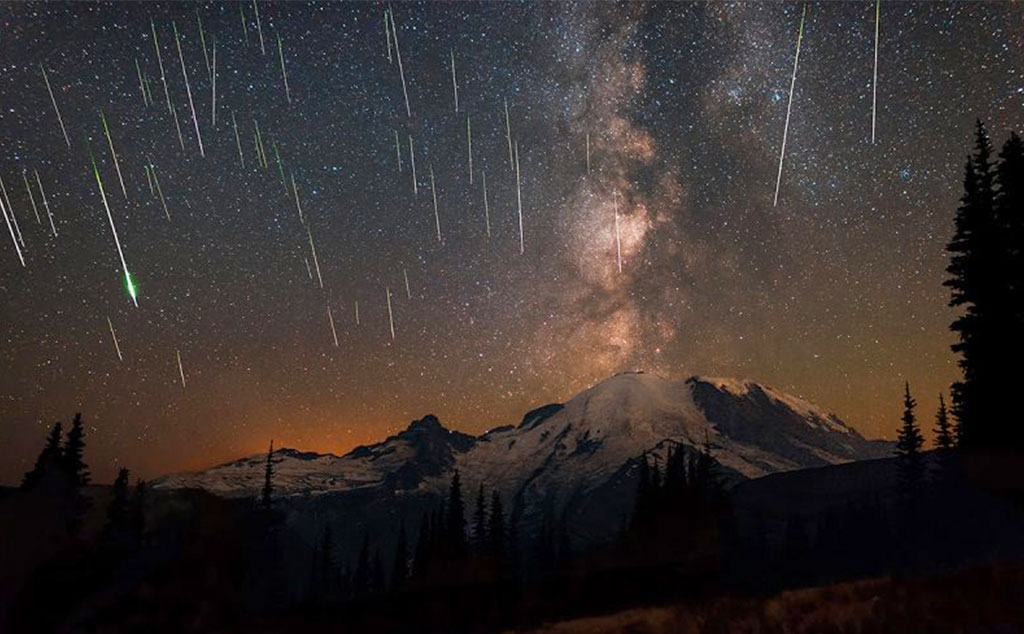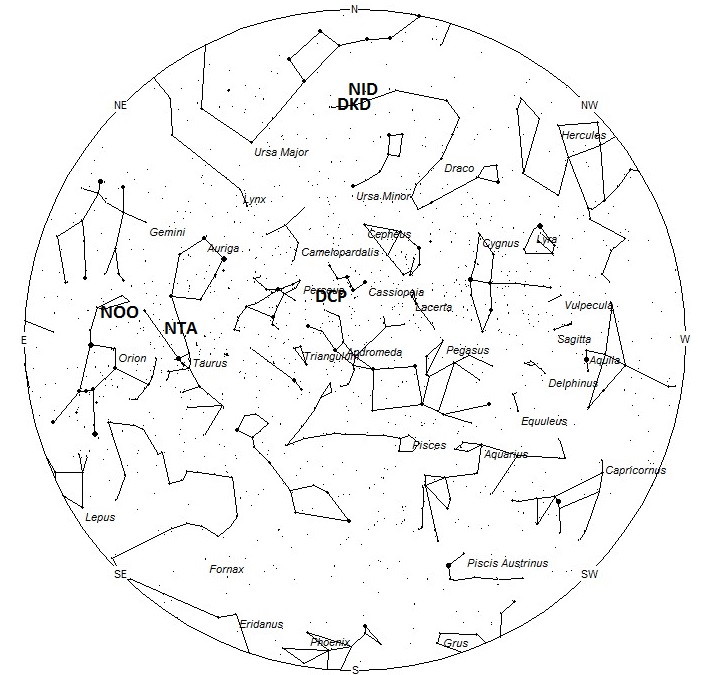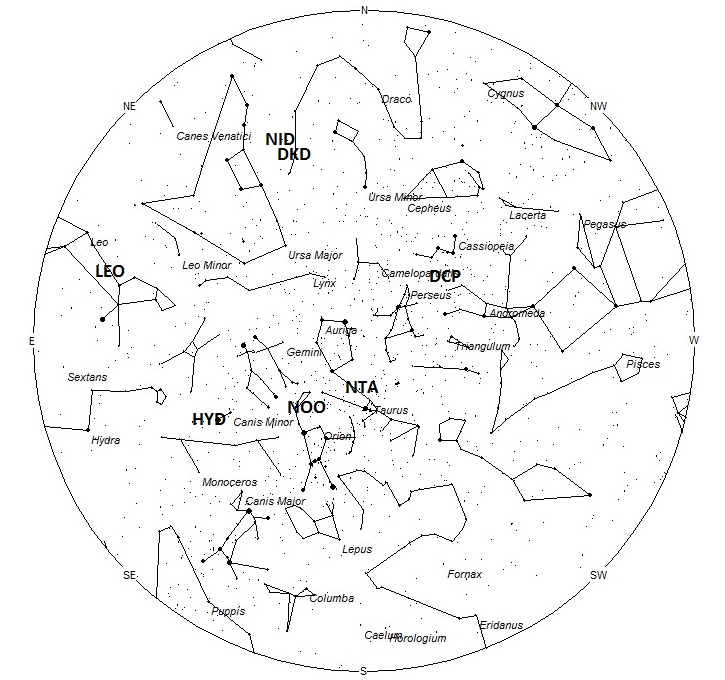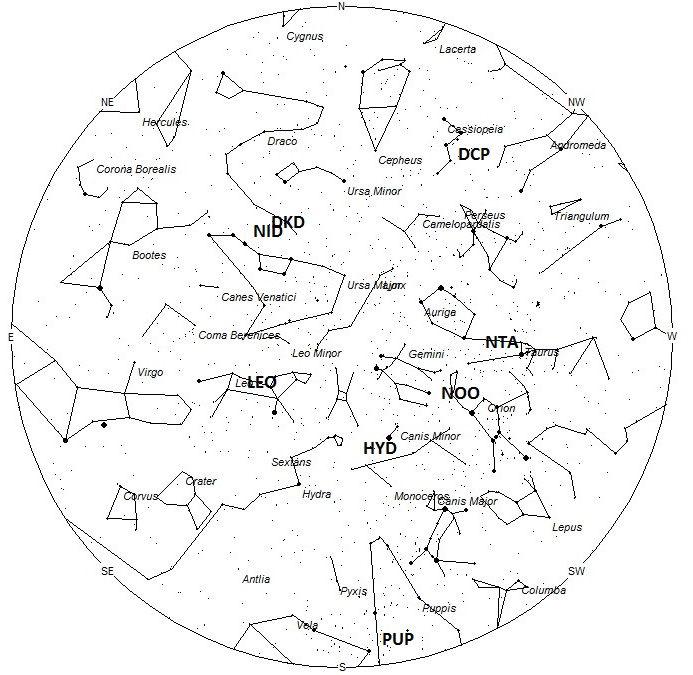
During this period the moon reaches its new phase on Tuesday November 29th. At this time the moon will be located near the sun and will be invisible at night. As the week progresses the slender crescent moon will enter the evening sky but will not cause any interference to those viewing meteor activity. The estimated total hourly meteor rates for evening observers this week is near 5 as seen from mid-northern latitudes (45N) and 4 as seen from tropical southern locations (25S). For morning observers the estimated total hourly rates should be near 18 as seen from mid-northern latitudes (45N) and 15 as seen from tropical southern locations (25S). The actual rates will also depend on factors such as personal light and motion perception, local weather conditions, alertness and experience in watching meteor activity. Note that the hourly rates listed below are estimates as viewed from dark sky sites away from urban light sources. Observers viewing from urban areas will see less activity as only the brightest meteors will be visible from such locations.
The radiant (the area of the sky where meteors appear to shoot from) positions and rates listed below are exact for Saturday night/Sunday morning November 26/27. These positions do not change greatly day to day so the listed coordinates may be used during this entire period. Most star atlases (available at science stores and planetariums) will provide maps with grid lines of the celestial coordinates so that you may find out exactly where these positions are located in the sky. A planisphere or computer planetarium program is also useful in showing the sky at any time of night on any date of the year. Activity from each radiant is best seen when it is positioned highest in the sky, either due north or south along the meridian, depending on your latitude. It must be remembered that meteor activity is rarely seen at the radiant position. Rather they shoot outwards from the radiant so it is best to center your field of view so that the radiant lies at the edge and not the center. Viewing there will allow you to easily trace the path of each meteor back to the radiant (if it is a shower member) or in another direction if it is a sporadic. Meteor activity is not seen from radiants that are located below the horizon. The positions below are listed in a west to east manner in order of right ascension (celestial longitude). The positions listed first are located further west therefore are accessible earlier in the night while those listed further down the list rise later in the night.
These sources of meteoric activity are expected to be active this week.
The December Phoenicids (PHO) are a periodic shower that rarely produces noticeable activity. The only impressive display produced so far by this shower occurred in 1956 when ZHR’s were near 100. These meteors at active from November 28-December 9 with a peak on December 6. The radiant is currently located at 00:44 (011) -52. This position lies in central Phoenix, 5 degrees southwest of the 3rd magnitude star known as beta Phoenicis. This area of the sky is best placed as soon as evening twilight ends. These meteors are best seen from the southern hemisphere where the radiant lies much higher in the sky. For those viewing from the northern hemisphere, only those in the northern tropics have any real chance of seeing activity from this source. At only 18 km/sec. the Phoenicids produce extremely slow meteors.
The December Phi Cassiopeiids (DPC) were discovered by Dr. Peter Jenniskens and are active from November 26 through December 5th. Maximum activity occurs on December 1st when the radiant is located at 01:33 (023) +53. This area of the sky is located in southern Cassiopeia, 3 degrees southeast of the faint star known as Theta Cassiopeiae. These meteors are best seen near 2100 (9pm) Local Standard Time (LST). Meteors from the December Phi Cassiopeiids strike the atmosphere at 17km/sec., which would produce meteors of very slow velocity. Expected rates would be near less than 1 no matter your location. It has been suggested that these meteors are a continuation of the Andromedids, but for now they remain separate.
The Northern Taurids (NTA) are active from a large radiant located near 04:48 (072) +25. This position lies in northern Taurus, 2 degrees northeast of 4th magnitude star known as tau Tauri. Rates at this time should be near 2 per hour as seen from the northern hemisphere and 1 as seen south of the equator. These meteors may be seen all night long but the radiant is best placed near midnight LST when it lies on the meridian and is located highest in the sky. With an entry velocity of 27 km/sec., the average Northern Taurid meteor would be of slow velocity.
The November Orionids (NOO) are active from a radiant located at 06:00 (090) +16. This area of the sky is located in extreme northeastern Orion, 8 degrees north of the bright orange star known as Betelgeuse (alpha Orionis). This location is close to the Northern Taurids , but far enough east to be distinguishable. The faster velocity of the November Orionids should help distinguish these meteors from the slower Taurids. The radiant is best placed for viewing near 0100 LST when it lies on the meridian and is highest above the horizon. This source is currently the strongest radiant in the sky with rates near 3 shower members per hour, no matter your location. With an entry velocity of 44 km/sec., the November Orionids would be of medium speed.
The Sigma Hydrids (HYD) are active from November 26 through December 21, with maximum activity occurring on December 6. The radiant is currently located at 07:48 (117) +05 , which places it in Canis Minor, just east of the brilliant zero magnitude star known as Procyon (Alpha Canis Minoris). These meteors are best seen near 0400 LST when the radiant lies highest above the horizon. Current rates should be near 1 per hour no matter your location. With an entry velocity of 62 km/sec., most activity from this radiant would be of swift speed.
The Puppid-Velids (PUP) are a vast complex of weak radiants located in the constellations of Puppis and Vela. Visual plots and photographic studies have revealed many radiants in this area during November and December. The combined strength of these radiants can produce a ZHR of ten. Actual hourly rates will be much less unless you happen to be observing from the deep Southern Hemisphere. Activity from this source begins around December 1st. The center of this activity is currently located at 07:48 (117) -45. This position lies in southern Puppis, 4 degrees southeast of the 3rd magnitude star known as sigma Puppis. Peak rates occur near December 7. These meteors are best seen near 0300 LST when the radiant lies highest above the horizon in a dark sky. Observers located in the Southern Hemisphere have an advantage viewing this shower as the radiant will rise higher into their sky allowing more activity to be seen. Since the radiant lies low in the south for most northern hemisphere observers, meteors seen from north of the equator tend to be long in length and long-lasting. At 40 km/sec. the Puppid-Velids produce meteors of average velocity.
The last of the Leonids (LEO) will be seen this week. The radiant is currently located at 10:40 (160) +19. This position lies in northern Leo, 4 degrees east of the second magnitude double star known as Algeiba (Gamma Leonis). The Leonid radiant is best placed during the last hour before morning twilight when the radiant lies highest in a dark sky. Leonids may be seen from the southern hemisphere but the viewing conditions are not quite as favorable as those north of the equator. With an entry velocity of 70 km/sec., most activity from this radiant would be of swift speed with numerous persistent trains on the brighter meteors.
The Psi Ursa Majorids (PSU) were discovered by observers in Japan using data from SonotaCo. This shower is active from December 1-16 with maximum activity occurring on December 4. At maximum the radiant is located at 11:16 (169) +44. This position lies in southern Ursa Major, one degree southeast of the third magnitude star known as Psi Ursae Majoris. This area of the sky is best placed during the last hour before dawn, when it lies highest above the horizon in a dark sky. Current rates would most likely be less than one per hour and may reach 1 per hour at maximum. Observers south of the equator would see rates less than 1 per hour due to the lower radiant elevation. At 61km/sec., the average Psi Ursa Majorid meteor would be swift.
The December Kappa Draconids (DKD) are another shower discovered in Japan by observers using data from SonotaCo. This short-lived shower is only active from December 2-6 with maximum activity occurring on December 3rd. On the night of maximum the radiant will be located at 12:22 (185) +70. This position lies in extreme western Draco, close to the faint star Kappa Draconis. While the radiant lies above the horizon all night for most of the northern hemisphere, it is best placed during the last hour before dawn, when it lies highest above the horizon in a dark sky. Rates could reach 3 per hour on the morning of the 3rd. Away from that morning I would expect hourly rates of less than 1. Due to the high northerly declination of the radiant these meteors are not visible from most of the southern hemisphere. At 41km/sec., the average December Kappa Draconid meteor would be of medium velocity.
The November Iota Draconids (NID) were discovered by Dr. Peter Brown during his 7 year meteoroid stream survey using the Canadian Meteor Orbit Radar. This source is active from November 11 through the 1st of December with maximum activity occurring on November 21st. The radiant is currently located at 12:44 (191) +66. This area of the sky lies in western Draco, close to the position occupied by a the faint star known as 7 Draconis. The radiant is best placed during the last hour before morning twilight when the radiant lies highest in a dark sky. Expect rates of less than 1 per hour no matter your location. Due to the high northerly declination of the radiant these meteors are not visible from most of the southern hemisphere. Only southern equatorial regions would have any chance of seeing activity from this source. Meteors from the November Iota Draconids strike the atmosphere at 41km/sec., which would produce meteors of medium velocity. Note that is radiant is very close to that of the December Kappa Draconids. An observer would have to be looking directly at the two radiant in order to separate meteors from these sources.
As seen from the mid-northern hemisphere (45N) one would expect to see approximately 12 sporadic meteors per hour during the last hour before dawn as seen from rural observing sites. Evening rates would be near 4 per hour. As seen from the tropical southern latitudes (25S), morning rates would be near 8 per hour as seen from rural observing sites and 3 per hour during the evening hours. Locations between these two extremes would see activity between the listed figures.
The table below presents a list of radiants that are expected to be active this week. Rates and positions are exact for Saturday night/Sunday morning except where noted in the shower descriptions.
| SHOWER | DATE OF MAXIMUM ACTIVITY | CELESTIAL POSITION | ENTRY VELOCITY | CULMINATION | HOURLY RATE | CLASS |
| RA (RA in Deg.) DEC | Km/Sec | Local Standard Time | North-South | |||
| Phoenicids (PHO) | Dec 06 | 00:44 (011) -52 | 18 | 20:00 | <1 – <1 | III |
| Dec. Phi Cassiopeiids (DPC) | Dec 05 | 01:33 (023) +51 | 19 | 21:00 | <1 – <1 | IV |
| Northern Taurids (NTA) | Nov 11 | 04:48 (072) +25 | 27 | 00:00 | 2 – 1 | II |
| November Orionids (NOO) | Nov 29 | 06:00 (090) +16 | 44 | 01:00 | 3 – 3 | II |
| Sigma Hydrids (HYD) | Dec 06 | 07:48 (117) +05 | 62 | 03:00 | 1 – 1 | II |
| Puppid-Velids (PUP) | Dec 07 | 07:48 (117) -45 | 42 | 03:00 | <1 – 2 | II |
| Leonids (LEO) | Nov 18 | 10:40 (160) +19 | 70 | 06:00 | <1 – <1 | I |
| Psi Ursa Majorids (PSU) | Dec 05 | 11:12 (168) +44 | 61 | 07:00 | <1 – <1 | IV |
| Dec. Kappa Draconids (DKD) | Dec 03 | 12:18 (184) +71 | 41 | 08:00 | <1 – <1 | IV |
| Nov. Iota Draconids (NID) | Nov 21 | 12:44 (191) +66 | 41 | 08:00 | <1 – <1 | IV |
 American Meteor Society
American Meteor Society


